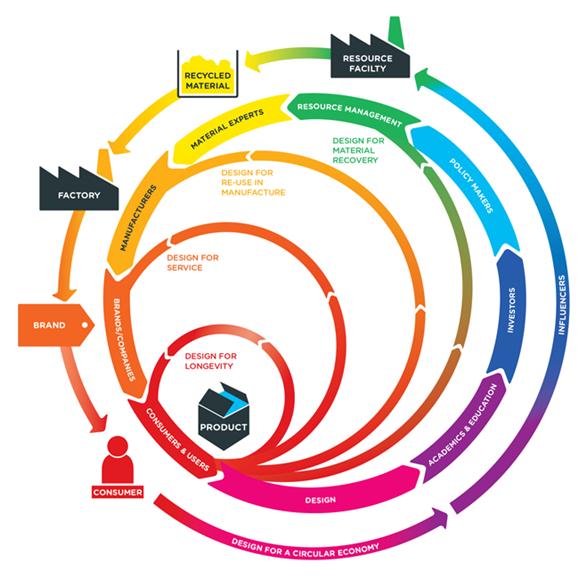On October 1, Acceleratio’s Managing Director Freek van Eijk participated in the Financial Times Sustainability Summit in London. After an introduction by Forum for the Future on the Circular Economy the topic was raised how to phase out waste and make a transition to a circular economy. The viewpoints from France and UK were shared just as the strategy of a company like Coca Cola Enterprises. Freek van Eijk brought in the Dutch experience which we gladly share with you.
Dear audience, I would like to share 3 aspects with you.
• What is happening on the waste management front in the NL
• Why we will have to look beyond waste management for answers
• I will give you 4 recommendations to make the transition to a Circular Economy
My country the NL’s seems to be doing pretty well on the waste management front. Less than 2 % of Municipal Solid Waste (MSW) is being landfilled, almost 80 % of all waste is recycled.
How are the Dutch rethinking waste from their seemingly advanced position?
Our current policy is called “from waste to resource”
• The residual waste (waste for energy-valorisation and landfilling) will have to be halved between 2012 and 2022. That’s 5 M tons for a small country!
More interesting this new policy makes initial steps into the production and consumption cycle.
• The government will give the example by making a start with green and circular public procurement.
• Our packaging agreement includes targets for an increase in recycled content for plastic bottles, thus creating a market pull for recyclables.
• Behaviors studies are part of the new policy because the targets require behavior changes of consumers and inhabitants.
We have realized that there are limits to the traditional end of pipe approach => we only tackle the visible aspects of an underperforming system. Even the Dutch will have to do more if they want to make a transition towards a circular economy.
Let me share 4 recommendations
1] We need to make an impact at the level of production and consumption
I believe that design is essential.
80% of the environmental impact of a product is determined at this stage.
We have to innovate at a systems level and that asks for co-creation.
• Design out waste in the production phase, usage phase and end-of-pipe. An example: many designers of plastic packages do not now that black plastics do not get detected by the NIR technology of plastic recyclers. Just changing the color makes it recyclable.
• In the design phase one should phase out scarce and hazardous substances [like PVC in plastics that can create benzene issues and prevent reuse].
• On the other end: Design in the use of recyclables or make the components bio-based and renewable.
• Design in reduced material usage, reuse, remanufacturing or refurbishment. Think of the modular Fair phone.
• Standardize where possible. Why do all smart phones have different chargers?
If you want to make material and energy to circle longer than new business models pop up on the horizon enabled by the digital revolution.
Good examples can be found in lease models where a service concept replaces the selling of a product.
With product ownership remaining with the producer resource effectiveness, longlivity and reuse make all of a sudden very much sense.
Consider also the sharing platforms. Did you know that an average drilling machine is only used 13 minutes in its entire life, yet everyone in my street has one. Wouldn’t it make sense to share tools or cars that are 90% of the time standing idle on a parking lot
2] We need to innovate our policies beyond waste management to create a market driver for circular economy!
The regulatory attention should shift from focus on end-of-pipe to the production chain. Ecodesign, Eco-labeling, Producer Responsibility and Green Public Procurement are key items of attention for the EU law makers. It makes no sense to have a regulatory push for recyclables if there is no market demand.
There are many obstacles ahead.
With waste becoming a resource you bump into regulatory challenges. Product regulation like REACH has never been set up with waste in mind. Regulation is still very sectorial and circular or system initiatives often ran into the strict limits of regulation and permits.
We have to keep the objective of protecting health and environment alive but allow for more experimentation and goal oriented approaches. New public-private “Green Deals” are popular at this moment in the Netherlands and allow for a common goal oriented approach.
The government must have the long term vision and facilitate the process towards it.
They could give the right incentives by Green Public Procurement, by unblocking barriers, by bringing stakeholders together around keys sectors.
They have to create and steer the conditions in order for the market to make a transition.
It means finding a win-win between economy and ecology
3] A transition needs also a behavior change of consumers. Awareness is step 1
You and me need to be sensible in what we buy. Do we really need to own a product? Could we do more in separating our waste?
Did you know that the volume of my residual bin at home reduced in volume with 60% just because I separate plastic packages? It made me aware of what I was buying and what how much I actually was throwing away
Good communication and feedback on the “why” and “how” are essential.
4] Producers will have to take responsibility for the whole value-chain of their products.
It is in their interest to see a transition towards a more Circular economy as an opportunity and not as a cost.
The Era of cheap and available resources, both biotic and a-biotic, is over! We are not in an Era of Change, we are in the Change of an Era. There is a clear and evident urgency.
Darwinism seems appropriate: not necessarily the strongest companies today will survive but the once most adaptable.
Circular Economy is about co-creation and collaboration. They will have to start the dialogue with their customers, value-chain partners and other stakeholders.
Take design and new circular business models serious and make a circular economy roadmap.
If you prefer to act from a Risk Perspective than please remember that in less than 4 years AirBNB has built up more value than the Hilton hotel chain
The Dutch are making good initial steps. An initial rather conservative assessment of the potential has been calculated at 7.3 billion euro’s and 54.000 jobs.
I believe we can make such a transition but we need to accelerate. Now you have guessed why I called my company Acceleratio.
Thank you for your attention


